GeNIe allows its user to compute expected value of information (VOI), i.e., the expected value of observing the state of a node prior to making a decision.
Definition of VOI and the formula for calculating it can be found in any decision-analysis textbook. An up to date list of textbooks covering the field of decision analysis can be found on BayesFusion's web site. Plainly speaking, VOI for an uncertain node x is the expected difference in expected utility (EU) for the two situations: (a) the node x has been observed, and (b) the node x is unobserved. We calculate the expected EU (yes, this is a double "expected") because we do not know a-priori which state of the variable we will observe. There are two important properties of VOI that can be proven easily: (1) Expected EU for (a) can never be smaller than EU for (b). The intuition behind it is that it is always better to know than not to know when making a decision. (2) It is always better to gather the information earlier than later, especially in earlier means before making a decision. Vito Corleone's consigliere, Tom Hagen, a character in Francis Ford Coppola's interpretation of Mario Puzo's Godfather, expresses this property eloquently in a conversation with Mr. Jack Waltz: "Don Corleone is a man, who insists on hearing bad news immediately."
We will use the influence diagram created in the Building an influence diagram section. If you do not have it saved, you can find a copy in the Example Networks folder (it is named VentureID.xdsl).
You should have the following network loaded in Graph View:
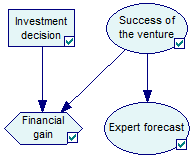
Select the Value of Information option from the Network Menu:
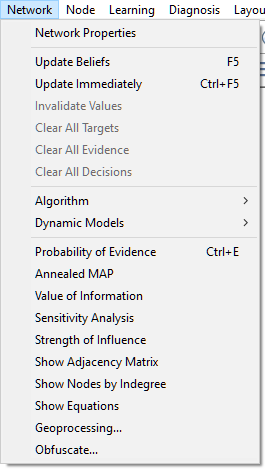
GeNIe will display the Value of Information dialog box as shown below:
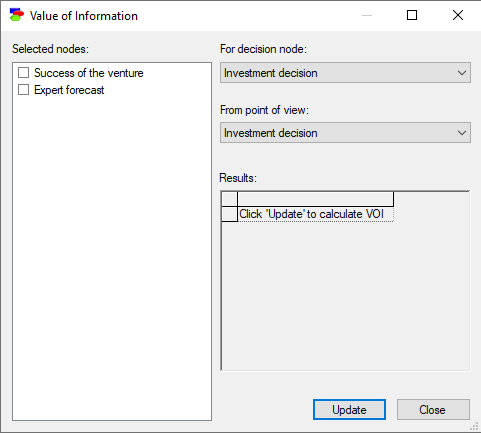
The left pane displays all chance and deterministic nodes in the model (our model contains only two of these).
The For decision node drop list displays the list of all decision nodes in the model. Because the model contains only one decision node, Investment decision, it is the choice. This drop list indicates the decision that will immediately succeed the observation.
The From point of view drop list displays the list of all decision nodes in the model. Because the model contains only one decision node, Investment decision, it is the choice. This drop list is used to select the node that is the reference point, i.e., from which point of view the value of information is being asked. This field is of importance only when there are more than one decision node and the decision to be made after observing the information is not the first decision to be made.
The Results pane displays the results of VOI calculation, once the Update button is clicked.
Suppose we want the value of information of the node Expert forecast. We proceed as follows:
1. Check the box next to Expert forecast in the left pane.
Because there is only one decision node, it is automatically selected in the For decision node and From point of view drop lists.
2. Click on the Update button to calculate VOI.
GeNIe will display the calculated value of information for the node Expert forecast, i.e., value of observing it before making the decision Investment decision, in the lower-right pane, as shown below:
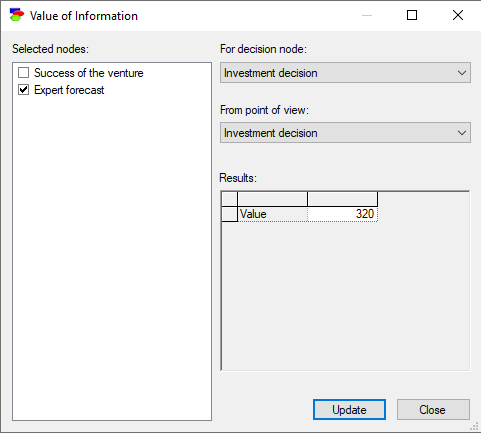
The forecast of our expert is worth $320 to our investor. This is the difference between the expected value of the optimal decision given perfect information about the node Expert forecast and the expected value of the optimal decision given no information about the node Expert forecast. A positive value means that knowing the value of the node Expert forecast will improve the expected value of the decision. A zero value would mean that learning the value of the node Expert forecast before making the decision has no impact on the decision. It can be proven that VOI calculation always yields a non-negative value - the intuition behind this is that we are never worse off by obtaining more information (in other words, it never makes sense not to know something that we could know).
Let us now examine the decisions that the investor will face after she has heard the forecast. To do so, we need to add an arc between the node Expert forecast and the node Investment decision, obtaining the following diagram:
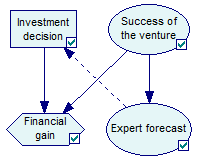
Please note that the arc between the nodes Expert forecast and Investment decision is dashed. Arcs entering decision nodes have a special meaning in influence diagrams - they are informational arcs and denote the fact that the decision maker will know the outcomes of the nodes at the tails of the informational arcs before she makes the decision.
Update the values using Update (![]() ) button from Standard Toolbar. After updating the values we observe the following result in the Value tab of the node Investment decision:
) button from Standard Toolbar. After updating the values we observe the following result in the Value tab of the node Investment decision:
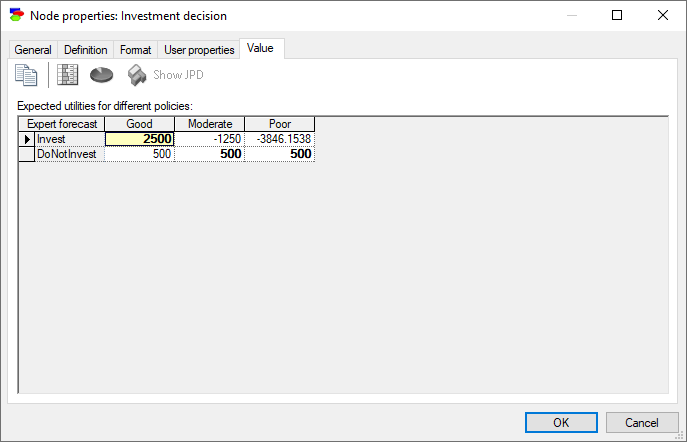
Our investor should ask expert opinion if expert opinion costs less than $320 (please note that this was the calculated value of information for the node Expert forecast) and in case the forecast is Good, she should invest in the venture. If the forecast is Moderate or Poor, however, she should not invest, as safe investment in a bank yields a higher expected value.
The above procedure computes the expected value of perfect information (EVPI). In order to compute the expected value of imperfect information (EVII) for a node N, you need to specify the reliability of the source of information about N by an additional node M, a direct descendant of N and then compute the EVPI for M. This will be equal to the EVII for N. This is, in fact, precisely what is being done by nodes Success of the venture and Expert forecast. We would love to know the value of the node Success of the venture. However, this is unattainable and the only thing we can obtain is imperfect information through Expert forecast. Node Expert forecast is such an imperfect source of information about the node Success of the venture. This imperfection is characterized by the probability distribution conditional on node Success of the venture. Within an influence diagram, there is no distinction between the value of perfect and imperfect information. Value of information, as calculated in an influence diagram is always the value of perfect information. It is the relationship between the observed variable and the variable that we are really interested in that make information perfect or imperfect.
Finally, we would like to caution our users against two common misconceptions of VOI that we have encountered in the past and that we responded to in our Forum. The first misconception relates to calculation of VOI for nodes that have deterministic marginal probability distributions in the sense of all but one of the probabilities being zeros. This happens, for example, in case of deterministic parent-less nodes (these are generally a bad modeling practice anyway) or in case of chance nodes that have been observed. VOI calculated for such nodes will be zero. The intuition behind this is that there is no uncertainty over such nodes and learning what we already know is essentially worthless from the point of view of decision making. The second misconception occurs when we ask for the value of information for a node that is a descendant of the decision node. Such a case is difficult to interpret theoretically and is essentially dismissed by GeNIe with a VOI equal to zero. On the one hand, the decision influences the marginal probability distribution over all of its descendants. On the other hand, when calculating the VOI over any of these nodes, these marginal will have to take part in the calculation. This is circular and, as we said above, difficult to interpret theoretically. A viable possibility in such a case is converting the influence diagram to so called canonical form, described in detail in a paper by Heckerman and Shachter (1995). In the canonical form, all descendants of the decision nodes are deterministic and all uncertainty resides in their ancestors. This modeling trick allows for asking VOI of these ancestors, which is typically the users' intention.